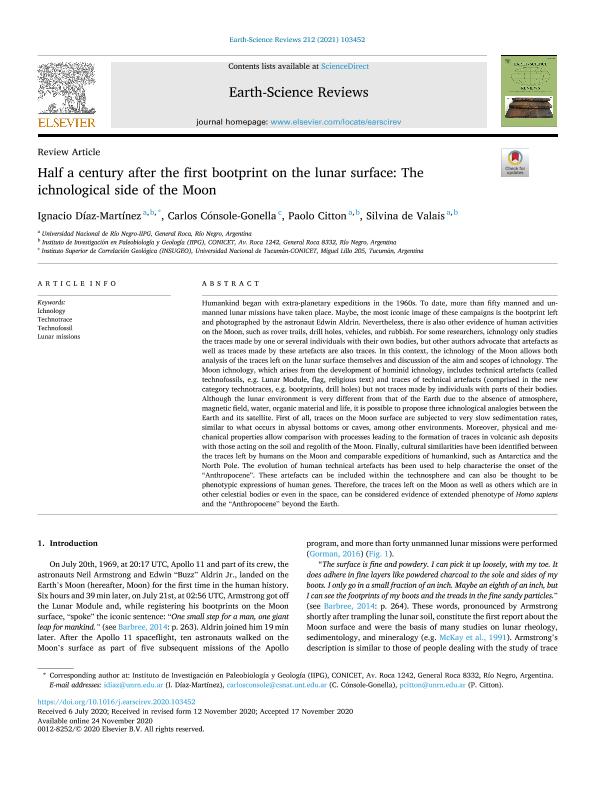Mostrar el registro sencillo del ítem
dc.contributor.author
Díaz Martínez, Ignacio

dc.contributor.author
Cónsole Gonella, Carlos Alfredo

dc.contributor.author
Citton, Paolo

dc.contributor.author
de Valais, Silvina

dc.date.available
2021-05-07T19:36:14Z
dc.date.issued
2021-01
dc.identifier.citation
Díaz Martínez, Ignacio; Cónsole Gonella, Carlos Alfredo; Citton, Paolo; de Valais, Silvina; Half a century after the first bootprint on the lunar surface: the ichnological side of the Moon; Elsevier; Earth-science Reviews; 212; 1-2021; 1-13; 103452
dc.identifier.issn
0012-8252
dc.identifier.uri
http://hdl.handle.net/11336/131705
dc.description.abstract
Humankind began with extra-planetary expeditions in the 1960s. To date, more than fifty manned and unmanned lunar missions have taken place. Maybe, the most iconic image of these campaigns is the bootprint left and photographed by the astronaut Edwin Aldrin. Nevertheless, there is also other evidence of human activities on the Moon, such as rover trails, drill holes, vehicles, and rubbish. For some researchers, ichnology only studies the traces made by one or several individuals with their own bodies, but other authors advocate that artefacts as well as traces made by these artefacts are also traces. In this context, the ichnology of the Moon allows both analysis of the traces left on the lunar surface themselves and discussion of the aim and scopes of ichnology. The Moon ichnology, which arises from the development of hominid ichnology, includes technical artefacts (called technofossils, e.g. Lunar Module, flag, religious text) and traces of technical artefacts (comprised in the new category technotraces, e.g. bootprints, drill holes) but not traces made by individuals with parts of their bodies. Although the lunar environment is very different from that of the Earth due to the absence of atmosphere, magnetic field, water, organic material and life, it is possible to propose three ichnological analogies between the Earth and its satellite. First of all, traces on the Moon surface are subjected to very slow sedimentation rates, similar to what occurs in abyssal bottoms or caves, among other environments. Moreover, physical and mechanical properties allow comparison with processes leading to the formation of traces in volcanic ash deposits with those acting on the soil and regolith of the Moon. Finally, cultural similarities have been identified between the traces left by humans on the Moon and comparable expeditions of humankind, such as Antarctica and the North Pole. The evolution of human technical artefacts has been used to help characterise the onset of the “Anthropocene”. These artefacts can be included within the technosphere and can also be thought to be phenotypic expressions of human genes. Therefore, the traces left on the Moon as well as others which are in other celestial bodies or even in the space, can be considered evidence of extended phenotype of Homo sapiens and the “Anthropocene” beyond the Earth.
dc.format
application/pdf
dc.language.iso
eng
dc.publisher
Elsevier

dc.rights
info:eu-repo/semantics/openAccess
dc.rights.uri
https://creativecommons.org/licenses/by-nc-nd/2.5/ar/
dc.subject
ICHNOLOGY
dc.subject
TECHNOTRACE
dc.subject
TECHNOFOSSIL
dc.subject
LUNAR MISSIONS
dc.subject.classification
Geociencias multidisciplinaria

dc.subject.classification
Ciencias de la Tierra y relacionadas con el Medio Ambiente

dc.subject.classification
CIENCIAS NATURALES Y EXACTAS

dc.title
Half a century after the first bootprint on the lunar surface: the ichnological side of the Moon
dc.type
info:eu-repo/semantics/article
dc.type
info:ar-repo/semantics/artículo
dc.type
info:eu-repo/semantics/publishedVersion
dc.date.updated
2021-04-28T21:04:55Z
dc.identifier.eissn
1872-6828
dc.journal.volume
212
dc.journal.pagination
1-13; 103452
dc.journal.pais
Países Bajos

dc.journal.ciudad
Amsterdam
dc.description.fil
Fil: Díaz Martínez, Ignacio. Consejo Nacional de Investigaciones Científicas y Técnicas. Centro Científico Tecnológico Conicet - Patagonia Norte. Instituto de Investigación en Paleobiología y Geología; Argentina. Universidad Nacional de Río Negro. Sede Alto Valle. Instituto de Investigaciones en Paleobiología y Geología; Argentina
dc.description.fil
Fil: Cónsole Gonella, Carlos Alfredo. Consejo Nacional de Investigaciones Científicas y Técnicas. Centro Científico Tecnológico Conicet - Tucumán. Instituto Superior de Correlación Geológica. Universidad Nacional de Tucumán. Facultad de Ciencias Naturales e Instituto Miguel Lillo. Departamento de Geología. Cátedra Geología Estructural. Instituto Superior de Correlación Geológica; Argentina
dc.description.fil
Fil: Citton, Paolo. Consejo Nacional de Investigaciones Científicas y Técnicas. Centro Científico Tecnológico Conicet - Patagonia Norte. Instituto de Investigación en Paleobiología y Geología; Argentina. Universidad Nacional de Río Negro. Sede Alto Valle. Instituto de Investigaciones en Paleobiología y Geología; Argentina
dc.description.fil
Fil: de Valais, Silvina. Consejo Nacional de Investigaciones Científicas y Técnicas. Centro Científico Tecnológico Conicet - Patagonia Norte. Instituto de Investigación en Paleobiología y Geología; Argentina. Universidad Nacional de Río Negro. Sede Alto Valle. Instituto de Investigaciones en Paleobiología y Geología; Argentina
dc.journal.title
Earth-science Reviews

dc.relation.alternativeid
info:eu-repo/semantics/altIdentifier/doi/http://dx.doi.org/10.1016/j.earscirev.2020.103452
dc.relation.alternativeid
info:eu-repo/semantics/altIdentifier/url/https://www.sciencedirect.com/science/article/pii/S0012825220304980
Archivos asociados
